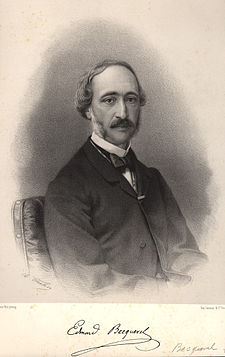Edmond Becquerel: Difference between revisions
No edit summary |
|||
| Line 52: | Line 52: | ||
== The First Photovoltaic Device == |
== The First Photovoltaic Device == |
||
In 1839, at age 19, experimenting in his father's laboratory, Bequerrel built the world's first photovoltaic. In this experiment, silver-chloride was place in an acidic solution and illuminated while connected to platinum electrodes, thus generating photovoltage and photocurrent. Due to this work, the photovoltaic effect has also been known as the "Becquerel Effect." |
In 1839, at age 19, experimenting in his father's laboratory, Bequerrel built the world's first photovoltaic. In this experiment, silver-chloride was place in an acidic solution and illuminated while connected to platinum electrodes, thus generating photovoltage and photocurrent. Due to this work, the [[photovoltaic effect]] has also been known as the "Becquerel Effect." |
||
== His works == |
== His works == |
||
Revision as of 02:54, 21 June 2012
A. E. Becquerel | |
|---|---|
 | |
| Born | 24 March 1820 |
| Died | 11 May 1891 (aged 71) |
| Nationality | French |
| Scientific career | |
| Fields | Physics |
Alexandre-Edmond Becquerel (24 March 1820 – 11 May 1891), known as Edmond Becquerel, was a French physicist who studied the solar spectrum, magnetism, electricity, and optics. He is known for his work in luminescence and phosphorescence. He is credited with the discovery of the photovoltaic effect, the operating principle of the solar cell, in 1839.[1][2] He was the son of Antoine César Becquerel and the father of Henri Becquerel.
Biography
Becquerel was born in Paris, and was in turn the pupil, assistant and successor of his father at the Musee d'Histoire Naturelle. He was also appointed professor at the short-lived Agronomic Institute at Versailles in 1849, and in 1853 received the chair of physics at the Conservatoire des Arts et Metiers. Becquerel was associated with his father in much of his work, but he himself paid special attention to the study of light, investigating the photochemical effects and spectroscopic characters of solar radiation and the electric light, and the phenomena of phosphorescence, particularly as displayed by the sulfides and by compounds of uranium. It was in connection with these latter inquiries that he devised his phosphoroscope, an apparatus which enabled the interval between exposure to the source of light and observation of the resulting effects to be varied at will and accurately measured.
Becquerel was an early experimenter in photography. In 1840 he discovered that the silver halides, natively insensitive to red and yellow light, became sensitive to that part of the spectrum in proportion to their exposure to blue, violet and ultraviolet light, allowing Daguerreotypes and other photographic materials to be developed by bathing in strong red or yellow light rather than by chemical treatment.[3] In practice this technique was rarely used. In 1848 he was able to produce color photographs of the spectrum, and also of camera images, by a technique later found to be akin to the Lippmann interference method, but the camera exposures required were impractically long and the images could not be stabilized, their colors persisting only if kept in total darkness.[4]
The First Photovoltaic Device
In 1839, at age 19, experimenting in his father's laboratory, Bequerrel built the world's first photovoltaic. In this experiment, silver-chloride was place in an acidic solution and illuminated while connected to platinum electrodes, thus generating photovoltage and photocurrent. Due to this work, the photovoltaic effect has also been known as the "Becquerel Effect."
His works
In 1867–1868 Becquerel published a treatise in two volumes called La Lumière, ses causes et ses effets. He also investigated the diamagnetic and paramagnetic properties of substances; and was keenly interested in the phenomena of electrochemical decomposition, accumulating much evidence in favor of Faraday's law of electrolysis and proposing a modified statement of it which was intended to cover certain apparent exceptions.
Awards
He was elected a member of the Royal Swedish Academy of Sciences in 1886.
The Bequerel prize for “outstanding merit in photovoltaics” is awarded annually at the European Photovoltaic Solar Energy Conference and Exhibition (EU PVSEC).
See also
- Phosphoroscope
- Photophone, an optical telephone, or radiophone, created in 1870 based on Becquerel's photovoltaic work
References
- ^ R. Williams (1960). "Becquerel Photovoltaic Effect in Binary Compounds". The Journal of Chemical Physics. 32 (5): 1505–1514. Bibcode:1960JChPh..32.1505W. doi:10.1063/1.1730950.
- ^ E. Becquerel (1839). "Mémoire sur les effets électriques produits sous l'influence des rayons solaires". Comptes Rendus. 9: 561–567.
- ^ E. Becquerel (1840). "Mémoire sur le rayonnement chimique qui accompagne la lumière solaire et la lumière électrique", Comptes Rendus 11:702–703.
- ^ E. Becquerel (1848). "L'image photographique colorée du spectre solaire", Comptes Rendus 26:181–183.
- This article incorporates text from a publication now in the public domain: Chisholm, Hugh, ed. (1911). Encyclopædia Britannica (11th ed.). Cambridge University Press.
{{cite encyclopedia}}: Missing or empty|title=(help)
Further reading
- A. Allisy (1 November 1996). "Henri Becquerel: The Discovery of Radioactivity". Radiation Protection Dosimetry. 68 (1): 3–10.
